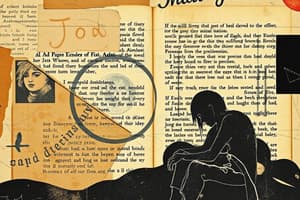Podcast
Questions and Answers
Which of the following statements is true about the Akkadian Victory Stele of Naram-Sin? (Select all that apply)
Which of the following statements is true about the Akkadian Victory Stele of Naram-Sin? (Select all that apply)
- The scene is taken from the Epic of Gilgamesh.
- The artwork was made to serve as a gravestone.
- The theme relates to a religious creation myth.
- The king is shown largest among all the figures. (correct)
The Human-Headed Winged Lion with the body of a lion, wings of a bird, and head of a human probably functioned as a(n)
The Human-Headed Winged Lion with the body of a lion, wings of a bird, and head of a human probably functioned as a(n)
- Guardian figure. (correct)
- King.
- Worshipper in the temples.
- Illustration of favorite stories.
Which term best describes the religion developed by Zoroaster, and adopted as part of Persian culture?
Which term best describes the religion developed by Zoroaster, and adopted as part of Persian culture?
- Anthropomorphic.
- Monotheistic.
- Dualistic. (correct)
- Polytheistic.
What classic struggle do Gilgamesh and Enkidu represent?
What classic struggle do Gilgamesh and Enkidu represent?
Visitors to the ziggurat often left statues representing themselves to
Visitors to the ziggurat often left statues representing themselves to
What is the term for endowing the gods and the forces of nature that they represent with humanlike traits, a characteristic of Mesopotamian religion?
What is the term for endowing the gods and the forces of nature that they represent with humanlike traits, a characteristic of Mesopotamian religion?
True or false: The process of brewing beer was developed by the Sumerians around 8000 years ago.
True or false: The process of brewing beer was developed by the Sumerians around 8000 years ago.
The gods granted Utnapishtim immortality because he
The gods granted Utnapishtim immortality because he
True or false: A ziggurat is a mountain-like platform upon which Sumerians placed their temples.
True or false: A ziggurat is a mountain-like platform upon which Sumerians placed their temples.
The Law Code of Hammurabi was created by the king of which civilization?
The Law Code of Hammurabi was created by the king of which civilization?
Flashcards are hidden until you start studying
Study Notes
Akkadian Victory Stele of Naram-Sin
- The artwork prominently features King Naram-Sin, who is depicted as the largest figure, symbolizing his importance.
- It serves as a historical representation rather than a gravestone or religious myth.
Human-Headed Winged Lion
- This creature combines the features of a lion, a bird, and a human head.
- Functioned primarily as a guardian figure, serving to protect spaces like temples.
Zoroastrianism
- Zoroaster developed a dualistic religion that became integral to Persian culture.
- Emphasizes a cosmic struggle between good and evil.
Epic of Gilgamesh Themes
- The characters Gilgamesh and Enkidu illustrate the conflict between nature and civilization.
- They represent broader themes of humanity's challenges.
Ziggurat and Statues
- Visitors to ziggurats often left statues of themselves as offerings to the gods.
- These statues served as prayer offerings, reinforcing the connection between individuals and deities.
Anthropomorphism in Mesopotamian Religion
- Mesopotamian religion often anthropomorphized gods, attributing human traits to deities and nature.
- This concept reflects the cultural view of the divine as relatable and human-like.
Brewing of Beer
- The Sumerians pioneered the brewing of beer approximately 8000 years ago, showcasing their advanced cultural practices.
Utnapishtim and Immortality
- Utnapishtim was granted immortality by the gods for surviving the Great Flood, paralleling themes in various flood myths.
Ziggurat Structure
- Ziggurats served as mountain-like platforms for temples, reflecting architectural advancements in Sumerian civilization.
Law Code of Hammurabi
- The creation of the Law Code of Hammurabi is attributed to the Babylonian civilization, establishing one of the earliest known legal codes.
Studying That Suits You
Use AI to generate personalized quizzes and flashcards to suit your learning preferences.




